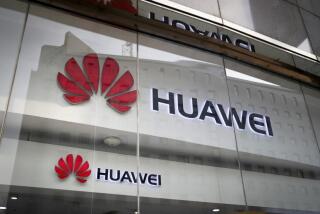IBM May Lead New High-Tech Revolution
- Share via
When IBM Corp. sold most of its personal computer business to China’s Lenovo Group two weeks ago, many pundits proclaimed it the end of an era for Big Blue.
More important, it’s also the beginning of one.
The PC, introduced by IBM in 1981, has pretty much led the development of electronics and computing technologies over the last two decades, as simple calculators have given way to powerful devices that design automobiles and airplanes. But now these adaptable instruments have become, in business parlance, mere “commodities.” Pricing has become cutthroat, and IBM’s market share has shriveled.
Yet as they close one chapter, the folks in Armonk, N.Y., are busy opening another. It’s called the Cell chip, a semiconductor containing potent microprocessors and communications transistors that could well lead the next generation of technological development.
Though specifics remain scant -- details aren’t expected until February -- those who have a sense of IBM’s project are practically giddy.
“It’s the biggest change in chip architecture in 20 years,” says Rick Gold, a partner at InnoCal Venture Capital, a Costa Mesa firm.
What makes the Cell potentially groundbreaking is the way it combines raw computing power with communications capabilities, enabling different types of contraptions -- televisions, refrigerators, cellular telephones, coffee pots -- to interact. As such, the Cell could well become the nerve center of the digital home, from the living room to the kitchen and beyond.
“It was born to network,” says Richard Doherty, head of Envisioneering Group, a firm in Seaford, N.Y., that evaluates technologies for both government and private industry (and isn’t at all connected with the IBM project).
It could take years for some of the most far-out scenarios -- clicking a button on your mobile phone, say, to start cooking the roast in your oven -- to become realities. In the meantime, IBM and its Cell partners, Sony Corp. and Toshiba Corp., are developing a workstation for interactive game playing and downloading entertainment features in the home.
Indeed, much of what is driving the Cell chip is fun and games.
Sony, for one, has been seeking a beefed-up microprocessor to enliven its next PlayStation game machine. “They needed better realization of the images and movement of characters,” explains Jim Kahle, an IBM technologist who has led the development of the Cell at a special facility in Austin, Texas. To help achieve that, IBM piled multiple processors and coprocessors on the same chip.
The effort appears to have paid off. Thomas Starnes, a semiconductor analyst at Gartner Group, notes that not only was IBM chosen to create the chip for Sony’s next PlayStation, but its technology will also be used by Nintendo Co. and Microsoft Corp. for their game consoles.
At this point, in fact, Kahle and his team are confident that their entertainment objectives have largely been met. But that’s only the beginning.
“It is like the early days of the PC,” Kahle says, “when all we had was the spreadsheet and really didn’t know all the things it would become.”
Of course, IBM and its partners don’t have the field to themselves. Fierce rivals, including Microsoft, Intel Corp. and Hewlett-Packard Co., are also eager to control the digital home.
Taken together, the products being introduced mark “the second revolution of microelectronics,” says Henry Samueli, chairman of Irvine-based Broadcom Corp., which itself makes about 500 chips for set-top boxes and other devices that help deliver entertainment to the living room.
But it is IBM that seems to have an early lead in the race -- a remarkable thing for an 80-year-old company that many dismissed as a dinosaur and left for dead only a decade ago.
Since then, IBM has improved its fortunes by relying less on peddling mainframe computers and more on providing information management services for corporate clients. Chairman Sam Palmisano is so confident that he has begun touting -- most recently in the Harvard Business Review -- how the company saved itself.
Notably, the turnaround did not come by shedding vital assets. Palmisano stresses, in particular, how he resisted pressure from Wall Street to dump IBM’s chip-making operations -- now the heart of the Cell project -- even though they are part of a group that lost $250 million last year.
That kind of farsighted thinking is all too rare in corporate America, so beholden are most executives to meeting quarter-to-quarter expectations.
Perhaps the next time an executive is forced to deal with such myopia, he’ll recall what IBM has done, and making the case for the long term won’t be such a hard Cell.
James Flanigan can be reached at jim.flanigan@latimes.com. For previous
columns, go to latimes.com/flanigan.
More to Read
Inside the business of entertainment
The Wide Shot brings you news, analysis and insights on everything from streaming wars to production — and what it all means for the future.
You may occasionally receive promotional content from the Los Angeles Times.








